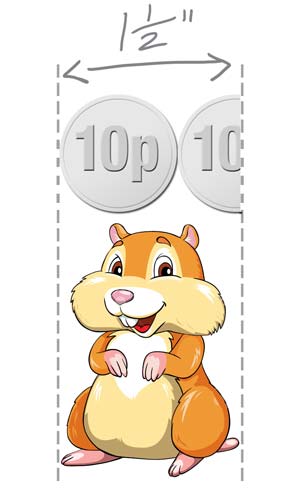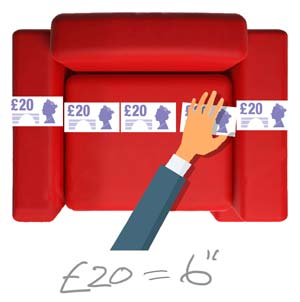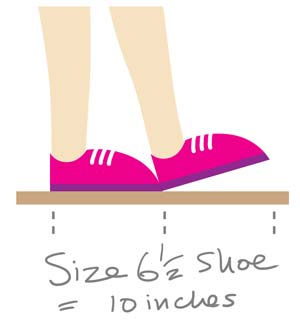How to Measure Things Without a Ruler
Quick confession: I don't take my ruler everywhere. Sometimes I just can't justify the extra baggage when I'm only dashing out for a sandwich, y'know?
But wait. Let's talk about that sandwich. In the advertisement, that sandwich looks spectacular: fluffy, thick bread sits atop a generous pile of pastrami and crunchy layers of pickle. Unwrapping the greaseproof paper reveals quite a different beast, however... flat, tired bread limply covers a wafer of pastrami and a small mound of pickle.
I KNEW I SHOULD HAVE BROUGHT MY MEASURING EQUIPMENT!
It's time to make a complaint about this sub-par sub, and you better believe I'm going to be quoting measurements at the sandwich CEO.
What should I do?! Here's the lowdown on measuring absolutely anything when you don't have a ruler.
Measuring small items (e.g. sandwiches, wallets, dolls' house furniture)
The bad news is that your great aunt Maude has sadly passed away, aged 105. The good news is that she's left you the Persian silk hamster hammock used by her long-departed rodent, Graham.

You decide that a hamster hammock needs a hamster, so you head down to the pet store to choose your new sidekick. But you need to be certain it will fit in the antique hammock.
Solution: easily measure an inch by placing a quarter dollar (US) or a 10p coin (UK) against the object (easiest if the hamster is sleeping, really).
If you don't have a coin, most people can measure an inch from the tip of their thumb to the first knuckle line on the inside of their thumb.
For metric measurements, 2cm is equivalent to a penny (UK) or a cent (US). If you have a credit card or ID card on you, it's most likely to be 85.60mm x 53.98mm (or 3.370" x 2.125").
Measuring medium-sized goods (e.g. furniture)
You've been given a job as a sales assistant in the local wig emporium, and when you see a high- backed, leather, Bond-villain chair in a furniture showroom, you can't help but feel it's exactly the thing to lend you some gravitas in your important new role. But how do you know for sure whether this armchair will fit in the booth?
Solution: Open your wallet and take out a dollar bill (or a £20 English banknote if you're really going authentic on the Bond villain thing).

Use the banknote to measure the furniture, by placing two of them end-to-end and moving note 1 to the end of note 2, then holding note 2 still and moving note 1 to the end of that, and so on, until you know how many banknotes in length it is.
Alternatively, if you only have one banknote, mark the place where its end reaches with your finger, and move the same banknote along, starting at the point where your finger is.
Then multiply the number of banknotes by 6, for inches, or 15 for cm: a dollar bill is 6 inches long (15.24cm), and a £20 English banknote is 14.9cm long (5.9 inches). You can even fold the banknote in half, then concertina the folds on each half to get a total of six equal width folds in the paper, helping you to measure the last few individual inches.
Measuring larger spaces (e.g. a room)
Your best friend, Tara, has gone out for the afternoon and you want to surprise her with a freshly decorated room when she gets back. No, you haven't checked with her first, but who wouldn't love the metallic ram-skull pattern on this fantastic black and green carpet?! The only thing is, you forgot to bring a tape measure and you don't know what size to buy the carpet.

Solution: walk along the edge of each wall, making sure to step heel to toe, and count the number of steps. Multiply the steps by your shoe measurement (you're in luck if you're an average height woman, because it's the easiest multiplier: a US 9 / EU 40 / UK 6.5 is 10" long).
Alternatively, measure your arm span against the wall; the distance between your outstretched fingertips is always very close to your actual height.
If you've got access to yarn or thread, cut it to the length of each wall, then fold in half, and half again, and half again (saves time on measuring). Use the credit card / dollar bill trick to discover the length of the folded string, and multiply by 8 to get the full measurement.
Measurements quick reference guide
- 2cm = one cent coin (US) or one penny (UK)
- 1 inch = a quarter dollar coin (US), one 10p coin (UK), or, generally, the tip of your thumb to the first knuckle line (inside thumb)
- 3.370 x 2.125 inches (85.60mm x 53.98mm) = most bank or ID cards
- 6 inches / 15cm = a dollar bill (US) or a £20 note (UK)
- 10 inches = average size ladies' shoe (EU size 40 / UK 6.5 / US 9)
- Fingertip to fingertip with your arms stretched is about the same as your height
Do you have some other ideas for everyday items that you could use for measuring? Join in the discussion below.
